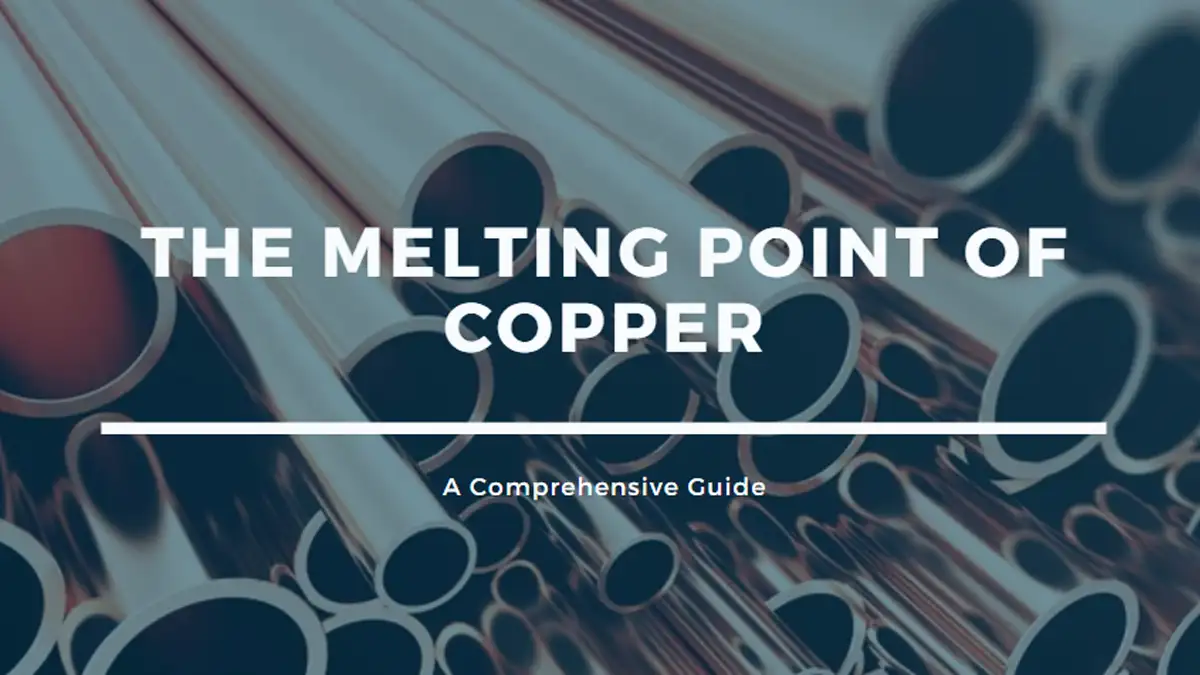Copper is a very versatile material commonly used for industrial and domestic purposes.
Copper and its alloys also play a vital role in various products due to their excellent corrosion resistance, strength, formability, and thermal and electrical conductivity.
Copper is easily weldable by arc gas and resistance welding techniques. Generally, copper is used in electrical wires and appliances due to its excellent electrical conductivity.
The temperature at which any solid starts to melt is called melting point. Pure copper’s melting point is lower than iron and steel’s. The melting point of copper is a significant consideration for metallurgists, engineers, and manufacturers.
Understanding these qualities is critical when designing and manufacturing copper-based products. This will help you to explore all the characteristics of copper and fundamental information about the melting point of pure copper and its alloys.
In this blog, we will explore all the fundamental facts about copper metal melting point. From what it is, factors affecting the melting point, and other heat or temperature characteristics.
What is the Melting Point of Copper?
Copper’s melting point, also known as its melting temperature, is an equilibrium point at which the metal exists in two phases. It is the temperature at which copper metal transforms from solid to liquid state.
Naturally, the copper substance undergoes numerous structural and chemical modifications throughout this transition. The melting point of copper is measured in Fahrenheit and Celsius.
The melting point of commercially pure copper is 1085 C° (1984 F), and copper alloys have different melting points due to their different compositions.
Why Know the Copper Melting Points
Understanding the melting point of copper or copper alloys before beginning a project is critical. This information is critical in determining if this alloy is appropriate for your application or project.
Knowing the melting point can also reduce the chances of copper structural failure caused by high temperatures that surpass the melting point. Knowledge assists in selecting the appropriate furnace and sources of energy for copper manufacturing and heat treatment.
Keep in mind that in most applications in structural engineering, failures like creep will develop when copper reaches the melting point. Determining the melting temperature of copper will allow you to operate the construction or manufacturing at safe temperatures.
Melting Point of Pure Copper
Ideally, pure copper melts at 1084 degrees Celsius (C), 1984 degrees Fahrenheit (F), and 1357 degrees Kelvin without additional additives or components.
A certain amount of heat is required to melt the copper, and this heat requirement is met by the specific temperature.
Copper’s melting temperature is sometimes defined in different quantities such as Rankine, electron volts, BTUs per pound, or joules per mole. All of these are taken from the temperature units mentioned above.
Melting Point of Copper Alloys
Cooper mixes with other elements, making alloys to fulfill the requirements of many applications because pure copper is very soft and malleable.
The melting temperature of pure copper will alter whenever any element is added to it. Usually, the melting point reflects the total alloy composition.
However, there is no limit to the number of elements combined with copper.
The melting points of some common alloys are shown in the given table:
Copper alloys | Melting temperature (°C) |
Arsenic copper | 685 |
Brass | 930 to 940 |
Bronze | 913 |
Beryllium copper | 870 to 980 |
Cupronickel | 1170 to 1240 |
Gunmetal | 900 to 1000 |
Chinese silver | 961 |
Copper’s melting point varies due to the alloy composition and impurities, as seen in the table. This has an impact on the sustainability of specific applications over time. A controlled processing approach is required to obtain the proper melting point in copper grades.
Ways of Melting Copper
There are various methods for melting copper and its alloys; in general, all of these are sources of the heat required to melt the copper. Heat will be used in this process to convert pure copper or copper alloy from solid to liquid.
The detail of some common methods is given below:
Electric resistance heating
Most copper alloys melt through this heating process, including brass. As electric current flows through copper alloy, it warms up and begins to melt.
Induction heating
Copper may be successfully heated and melted using oscillators, electromagnets, and a high-frequency alternating current (AC).
Laser heating
A high-power laser beam is used to heat the copper alloys for melting.
Electron beam melting
In this process, the high-energy electron beam is used to melt the copper metal and its alloys. These electronic beams are suitable to raise copper temperatures above the melting point.
Arc melting
In the arc melting process, a large amount of electric current is required to melt the copper and alloys.
Oxy-fuel Torch
A combination of two gases, propane and oxygen, is used to produce a flame for heating the copper above its melting point.
Electric current heating
Plasma arc melting
Plasma arc melting is a high-temperature method for melting copper. The combination of gases, such as argon or nitrogen, is utilized to create a high-temperature plasma arc.
Vacuum melting
A vacuum chamber will allow you to melt copper without the risk of contamination. Copper can be easily melted at high temperatures.
Comparing Melting Points of Other Metals and Copper
Due to the different composition and microstructure, the metals have different melting points. The melting point comparison of copper and other metals is given below in the table:
Alloys | Melting point (°C) |
Copper | 1084 |
Aluminum | 660 |
Carbon steel | 1371 to 1593 |
Cast iron | 1127 to 1204 |
Cobalt | 1495 |
Chromium | 1860 |
Inconel | 1390 to 1425 |
Incoloy | 1390 to 1425 |
Stainless steel | 1510 |
Nickel | 1453 |
Titanium | 1670 |
Tungsten | 3400 |
Magnesium | 349~649 |
How to Melt Copper
The melting process of copper includes the following points:
- Start this process by selecting the proper tools, equipment, and a standard procedure for copper melting.
- Prepare the copper material you were going to melt. You can clean and divide it into little pieces.
- Wear safety gear, and ensure that there is adequate ventilation.
- Put the copper stuff in the melting furnace and heat it to get the necessary copper melting temperature.
- At the end of the process, molten copper is transferred into desired shapes or ingots.
How Copper Melting Point Determine Practical Application
Beyond the melting point, when copper melts, its physical and mechanical properties are changed. At this stage, copper and copper alloys can only result in component failure. Some practical applications of copper and its alloys are given below:
Welding, Soldering, and Brazing
These days, several copper brazing and welding rods are used in many applications. For this purpose, it is very important to know the melting point of copper. Copper melts during welding, facilitating the connecting process.
Electrical Applications
Due to its exceptional thermal and electrical conductivity, copper and its alloys are mostly used in many electrical appliances such as wires, motor windings, heat exchangers transformers, and heat sinks.
Understanding the thermal characteristics and melting points of copper alloys is essential for their use in various applications.
Casting and Molding Applications
During casting operations, understanding the melting temperature of copper will assist you in selecting the appropriate furnace and tooling equipment. Casting copper allows you to create a variety of objects, such as sculptures, plumbing fittings, jewelry, and car parts.
Conclusion
In conclusion, copper is a useful material and is mostly used in industries and household items due to its excellent properties. The melting point of copper also plays a very important role in its common applications.
At HZW, we are your trusted copper strip foil in China. For all your transformer and cable copper foils, contact us now for competitive prices.
More Resources:
Melting Points of Metals – Source: Online Metals
Metal Alloys Melting Point – Source: Engineering Toolbox
The Melting Point of Metals – Source: Metal Supermarket












